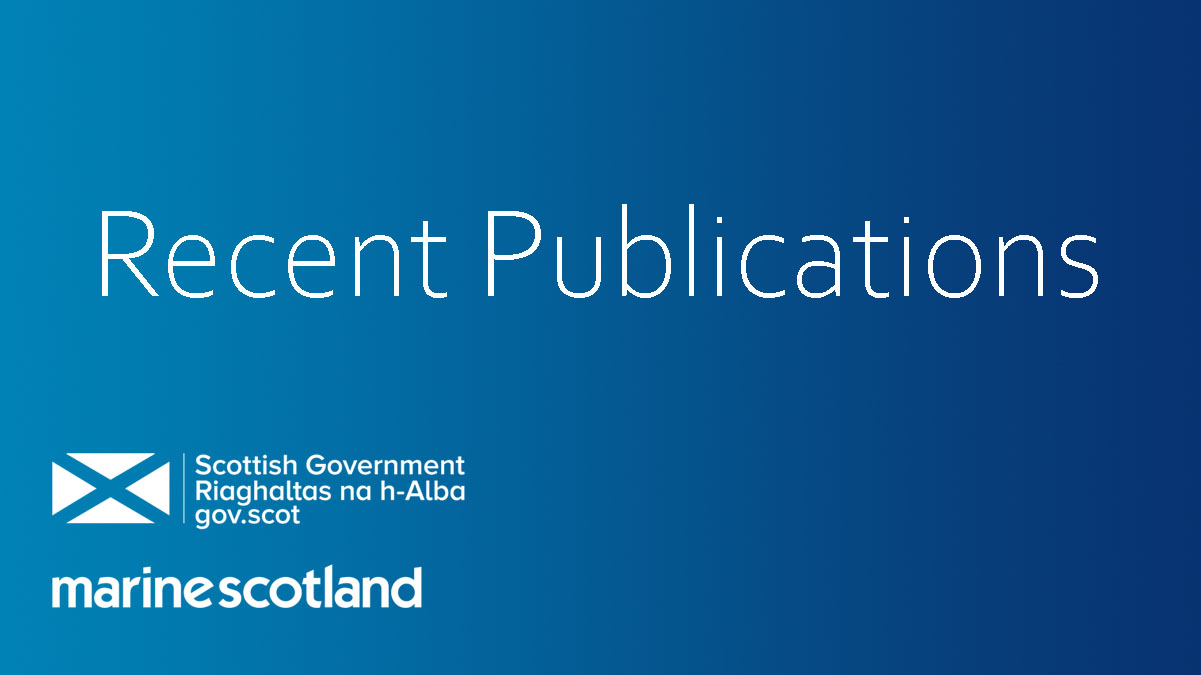Marine
Recent Marine Scotland Science Publications
June 9, 2020 by Marine Directorate Communications No Comments | Category Marine Directorate general, Publications
Marine Scotland Science, as a core Scottish Government (SG) Division, is working to support SG’s overall COVID-19 response. It also continues to sustain critical marine science delivery and has over the last month produced the following notable publications:
- Armstrong, J.D., Branding, A., Main, R., Mitchell, A., Morris, D. & Ounsley, J. (2020). Science for crafting policy: acoustic tracking of salmon smolts and post-smolts. The SAMARCH Project International Salmonid Coastal and Marine Telemetry Workshop (Edited by: K. Whelan, D. Roberts and J. Gray), pages 81-84.
https://samarch.org/wp-content/uploads/2020/05/SAMARCH-Tracking-Conference-Nov-2019-final_compressed.pdf
This paper considered options for using acoustic tracking of salmon smolts at sea to develop marine spatial planning in coastal zones and cautioned against using loss rates of tagged fish to infer impacts of predators without verifying methods appropriately. - ICES. 2020. Working Group on Marine Mammal Ecology (WGMME). ICES Scientific Reports, 2:39. 85pp. http://doi.org/10.17895/ices.pub.5975
Publications Report: Expert Group Report: EPDSG WGMME2020 pdf - Jackson, F.L., Fryer, R.J., Hannah, D.M. & Malcolm, I.A. (2020). Predictions of national‐scale river temperatures: A visualisation of complex space–time dynamics. Hydrological Processes, 2020; 1– 3.
https://doi.org/10.1002/hyp.13761.
This paper modelled and visualised river temperatures across Scotland during the extreme hot summer of 2018 to assess which of Scotland’s rivers were affected by temperatures that exceeded critical thresholds for Atlantic salmon and to inform management response to climate change. - Morris, D., Godfrey, J., Gauld, N., Raffell, J. & Armstrong, J.D. (2020). Acoustic tracking of sea trout and salmon smolts using a grid arrangement of acoustic receivers in a Scottish sea loch system. The SAMARCH Project International Salmonid Coastal and Marine Telemetry Workshop (Edited by: K. Whelan, D. Roberts and J. Gray), pages 32-34.
https://samarch.org/wp-content/uploads/2020/05/SAMARCH-Tracking-Conference-Nov-2019-final_compressed.pdf
This paper evaluated details of tracking approaches for providing information on distributions of salmon and sea trout in the Scottish west coast in support of aquaculture planning. - Munro, L.A. (2020). Scottish shellfish production survey 2019. Scottish Government, Aberdeen.
https://www.gov.scot/publications/scottish-shellfish-farm-production-survey-2019/pages/3 and data at
https://data.marine.gov.scot/dataset/scottish-shellfish-farm-production-survey-data
This publication provides data essential for assessing the state of the Scottish shellfish industry for SG policy, for UK food security, and for EuroStat and FAO aquaculture and food security assessments.
- Murray, S.A., Thompson, H.P., Spence, M.A., Pinnegar, J.K., Greenstreet, S., Moriarty, M., Hélaouët, P. & Lynam, C.P. (2020). A feeding guild indicator to assess environmental change impacts on marine ecosystem structure and functioning. Journal of Applied Ecology.
https://doi.org/10.1111/1365-2664.13662.
This paper provides information for assessing responses of wild fish populations and ecosystems to climate change. - Priede, I.G., Burgass, R.W., Mandalakis, M., Spyros, A., Gikas, P, Burns, F. & Drewery, J. (2020). Near-equal compressibility of liver oil and seawater minimises buoyancy changes in deep-sea sharks and chimaeras. Journal of Experimental Biology, 11 May 2020.
https://jeb.biologists.org/content/223/9/jeb222943
The physical properties of oils stored in the liver of deep-sea sharks and chimaeras show that water temperature rather than depth (pressure) is important in regulating the buoyancy of these species during vertical migrations.
Video talk:
Meadhbh Moriarty. (2020). Evaluation of multiple coupled biological-physical models in Loch Linnhe.
https://www.youtube.com/watch?v=aTM7Jxc4TK8.
This presentation describes ongoing work on sea lice dispersal modelling to inform area management of salmon farms, and farm interactions with wild salmonids.
Additional Information
- Scottish Government – Marine Scotland
- Journal of Experimental Biology
- SAlmonid Management Round the Channel (SAMARCH)
- Hydrological Processes
- Journal of Applied Ecology
- International Council for the Exploration of the Sea (ICES)
Tags: chimaeras, deep-sea sharks, ICES, Marine Spatial Planning, publications, SAMARCH, tracking salmon, tracking sea trout, WGMME



Leave a comment